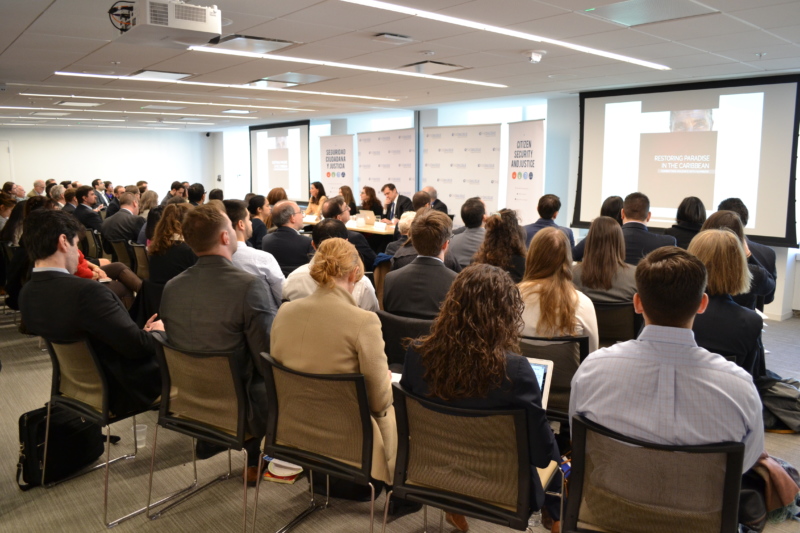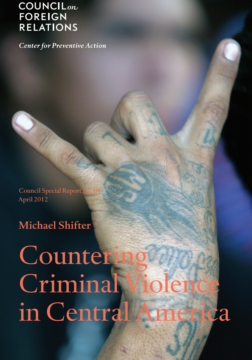IACHR Report on Citizen Security & Human Rights
Citizen security remains a top concern for most Latin American governments as crime and violence spiral out of control and cripple political and economic institutions in the region.
The Dialogue, together with the Inter-American Development Bank (IDB), hosted an event on March 2nd to launch the study “The Cost of Crime in Latin America and the Caribbean” with Nathalie Alvarado, Principal Specialist in Citizen Security at the IDB; Laura Jaitman, Citizen Security Specialist at the IDB; Angela Me, Chief of the Research and Trend Analysis Brand at the UNODC; Desmond Arias, Associate Professor at Georgetown University; and Michael Shifter, President of the Dialogue.
The greatest concerns of people in Latin America are the humanitarian and economic consequences of insecurity. Alvarado started the conversation by highlighting that Latin America is the most dangerous region in the world. Crime and violence pose a great economic and humanitarian challenge in the region; “it affects the behavior of individuals, constraints investment, erodes trust in institutions, as well as distorts the allocation of private and public resources”. The report shows how crime and violence have a “big impact in social and economic development”. The intention is to facilitate the decision making process and better allocate resources in order to create evidence based policies.
"Crime and fear of crime poses challenges not only for individuals, but for the economies of Latin America"
— The Dialogue (@The_Dialogue) March 2, 2017
- @CSJNathalie #CostofCrime pic.twitter.com/8CJcvowGTy
Jaitman continued with a summary of the report. She explained that the main goal of public policies is to efficiently allocate a state’s limited resources to increase the welfare of their citizens. This study shows that crime generates economic losses. Crime alters citizens’ decisions, behaviors, and states’ distribution of resources. Thus, if governments are able to reduce crime and its costs, they will be able to increase welfare. Jaitman stressed that the costs of crime are high in Latin America. This region has a homicide rate of 24 per 100,000 citizens, four times the global rate. She highlighted, however, that the aggregate disguises heterogeneity among the countries, being El Salvador and Honduras the ones with the highest homicide rates, around 60 per 100,000, and Chile the one with the lowest crime rates, with 20 times fewer homicides. Furthermore, there is also heterogeneity within the countries.
The challenge is to estimate the costs of crime in order to address them and increase welfare. This report used the accounting methodology that “puts in terms of money some of the components of the costs of crime”. The study systematically analyzes 17 countries in Latin America and 6 developed countries. The costs of crime included in this report are: public expenditure on security, private expenditure on security, and social costs of crime. Social costs of crime refer to the estimation of the foregone income of victims of homicide and of incarcerated perpetrators.
"The #CostofCrime is a huge challenge, but information and good diagnostics are the first steps to finding solutions"
— The Dialogue (@The_Dialogue) March 2, 2017
- @laurajaitman
The main finding is that the cost of crime comprises 3.5% of GDP, one dollar per person per day. Jaitman stressed once more that there is heterogeneity in the cost of crime in Latin America, Central America’s percentage being higher than the average with 4.5% of GDP. Latin America’s cost of crime as a percentage of GDP is double of that in developed countries. Jaitman highlighted that this money would be enough to eradicate world hunger for 5 years, double the region’s total annual spending on infrastructure, halve the region’s housing deficit, or increase by 50% the spending on education. Thus, the cost of crime provides an opportunity cost that could be allocated towards development. The heterogeneity of the countries suggests a need for diverse and personalized policies, founded on factual information.
Most of this spending goes to public spending, followed by private spending, and social costs. The study found that private spending is more correlated with homicide rates than public spending, implying that the private sector is adapting quicker to crime rates. Public spending on crime accounts for about 1.5% of GDP; it is more than three times what is spent on poverty reduction programs. Moreover, most of it is spent on police. The report’s main finding is that the high levels of spending on crime are not successfully diminishing crime; therefore, there is a need for better policies and a more efficient allocation of public spending.
Following Jaitman, Angela Me underscored the difference between cost of crime and cost of insecurity. Most of the studies in the subject focus on the costs of insecurity. Not all crime is insecurity and not all insecurity is crime. She also highlighted the invisible cost of organized crime; she explained that organized crime can operate in peaceful environments. In fact, in Latin America there are countries with high levels of cocaine transit and high homicide rates, others with high levels of cocaine transit and low homicide rates, and countries with low levels of cocaine transit and high homicide rates. Corruption plays a role in explaining these irregularities; if the government is decentralized so is corruption increasing violence. For example, the reduction of the cocaine market in Mexico has generated more violence as groups fight each other in the reduced supply market. To sum up, Me argues for the need to measure the invisible costs of crime.
"Organized crime creates a vicious cycle that reduces investment and rule of law"
— The Dialogue (@The_Dialogue) March 2, 2017
- Angela Me of the @UNODC #CostofCrime pic.twitter.com/F8GRbEsP3a
“Organized crime can operate in peaceful mode, with little impact on security, but creating a distorted economic and social environment with high costs on society, economy, environment, human rights and rule of law which are not measured in terms of insecurity costs”.
Why is it important to quantify the “invisible” cost of organized crime? “Surveys show that many citizens are willing to trade their civil rights for security, and some are even beginning to doubt that democracy is the best form of government for their countries” (page 110 of the report). For Me, it is urgent to quantify the invisible cost of organized crime, since it is “important to balance interventions with a long term vision addressing violence together with long term impact of organized crime on development, human rights, and rule of law”.
Desmond Arias concluded the speaking section by raising some issues. He found that smaller countries and smaller population states in Brazil seem to have relatively higher costs than larger countries and larger population states which suggest that there is an economy of scale issue. Moreover, there is an inference made in the Brazil case that wealthier states have less crime than poor states. However, Sao Paolo used to have the highest rates in the 1980s-1990s. For Arias, this change seems to be more linked to a historical change than to crime itself since Brazil has steadily reduced its crime rates. Instead, Arias thinks it might be related to the theory that the rise of crime is connected to consumer demand. An increase in the quality of life is associated with high levels of crime since it increases the crime demand on the population.
As for the social costs of crime, Arias referenced the moral aspect of having experienced crime. There is sense of violation that is not studied in a purely cost-benefit analysis. Citizens experience a feeling of alienation and unresponsiveness from the state. People’s sense of justice is not being met. Finally, he highlighted the role of political elites in sustaining corruption for profit, as a part of their governance strategy, or because it helps minimize potential violence.
Watch the full recording of the event here:
Citizen security remains a top concern for most Latin American governments as crime and violence spiral out of control and cripple political and economic institutions in the region.
Medellín is Colombia’s second largest and fastest growing city, but also the most dangerous major city in the country.
Violent crime in Central America, particularly in the “northern triangle,” is reaching breathtaking levels.
 Irene Estefanía González / Inter-American Dialogue
Irene Estefanía González / Inter-American Dialogue
